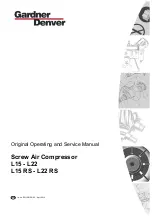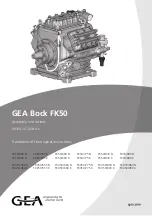
26
Installation
After the system is leak-free and evacuation has
been completed, it is ready for charging. Before
actual charging, however, the entire operation of
the refrigeration system should be inspected as
outlined below:
A.
Low Side Equipment
1.
Fans on air handling equipment running.
2.
Pumps on water cooling equipment running.
3.
Proper location and attachment of thermo-
static expansion valve bulb to suction line.
4.
Correct fan and pump rotation.
5.
Evaporator pressure regulators and solenoid
valves open.
6.
Water pumps and motors correctly aligned.
7.
Belt drives correctly aligned and tensioned.
8.
Proper voltage to motors.
B.
Compressors
1.
Proper oil level.
2.
Voltage agrees with motor characteristics.
3.
Properly sized motor fuses and heaters.
4.
Direct drivers aligned and couplings tight.
5.
All suction and discharge valves open.
6.
All transducers and RTD’s calibrated and
reading correctly.
C.
Condensers
1.
Water available at water cooled condensers
and supply line valve open.
2.
Water in receiver of evaporative condenser
and makeup water available.
3.
Correct rotation of pump and fan motors.
4.
Belt drives aligned and tensioned correctly.
5.
Pump, fans and motors lubricated.
D.
Controls
Controls should be at the initial set points. See
microprocessor manual for further information.
E.
Initial Charging – High Side Charg-
ing
There are two methods of charging refrigerant into
the system, through the “high side” or through
the “low side”. High side charging is usually
used for initial charging as filling of the system is
much faster. Low side charging is usually reserved
for adding only small amounts of refrigerant after
the system is in operation.
High side charging of refrigerant into the sys-
tem is accomplished as follows:
1.
Connect a full drum of refrigerant to the
liquid charging valve. This valve is gener-
ally located in the liquid line immediately
after the king or liquid line valve. Purge
the air from the charging line.
2.
Invert the refrigerant drum if the drum is
not equipped with “Liquid” and “Vapor”
valves, and place in such a position so the
liquid refrigerant only can enter the sys-
tem. Close the liquid line or king valve, if
it is not already closed. Open the “Liquid”
charging valve slowly to allow refrigerant
to enter the system. The vacuum in the
system will draw in the refrigerant.
It is important that, during this operation,
air handling units be running and water is
circulating through the chillers. The low
pressures on the system can cause the re-
frigerant to boil at low temperature and
possibly freeze the water if it is not kept
circulating.
Water freezing in a chiller can rupture the
tubes and cause extensive damage to the
system. It would be desirable to charge the
initial amount of refrigerant without water
in the shell and tube equipment to elimi-
nate the possibility of freeze up.
3.
After some refrigerant has entered the sys-
tem, the compressor unit starting procedure
may be followed. See Start-Up and Opera-
tion Section of this manual.
4.
Continue charging refrigerant into the sys-
tem until the proper operating requirements
are satisfied. Then, close the liquid charg-
ing connection and open the liquid line
valve allowing the system to operate nor-
Summary of Contents for VSM 71-701
Page 1: ...1 VPN 35391S February 2006 Rev 05 Price 60 00...
Page 2: ...2...
Page 20: ...20...
Page 52: ...53 Pre Start Up Check List...
Page 99: ...99 Recommended Spare Parts List...
Page 104: ...104 Gate Rotor...
Page 110: ...110 Main Rotor VSS...
Page 112: ...112 Main Rotor VSR...
Page 114: ...114 Slide Valve Cross Shafts and End Plate...
Page 118: ...118 Capacity Slide Volume Slide Carriage Assembly Slide Valve Carriage Assembly...
Page 134: ...134 Miscellaneous Frame Components VSS Screw Compressor VSR Mini Screw Compressor...
Page 138: ...138 C FlangeAdapter Components 630 620 610 640 601 641 630 601 620 610 640 641 642 650 651...
Page 140: ...140 Replacement Parts Tools...
Page 144: ...144 GaterotorAssembly...
Page 148: ...148 Main Rotor Slide Valve Cross Shafts and End Plate Models 71 401 Only Counter clockwise...
Page 152: ...152 Main Rotor Slide Valve Cross Shafts and End Plate Model 501 701 Only Clockwise...
Page 154: ...154 Volume Ratio Capacity Slide Carriage Assembly Slide Valve Carriage Assembly...
Page 158: ...158 Miscellaneous Frame Components Model VSM 501 701 Model VSM 71 401...
Page 160: ...160 Replacement Parts Accessories Housing Accessories C Flange Assembly...
Page 166: ...166 Haight Pumps...
Page 170: ...3 Refrigerating Specialties Division...
Page 236: ......
Page 237: ......
Page 238: ......
Page 243: ......
Page 244: ...168...
















































